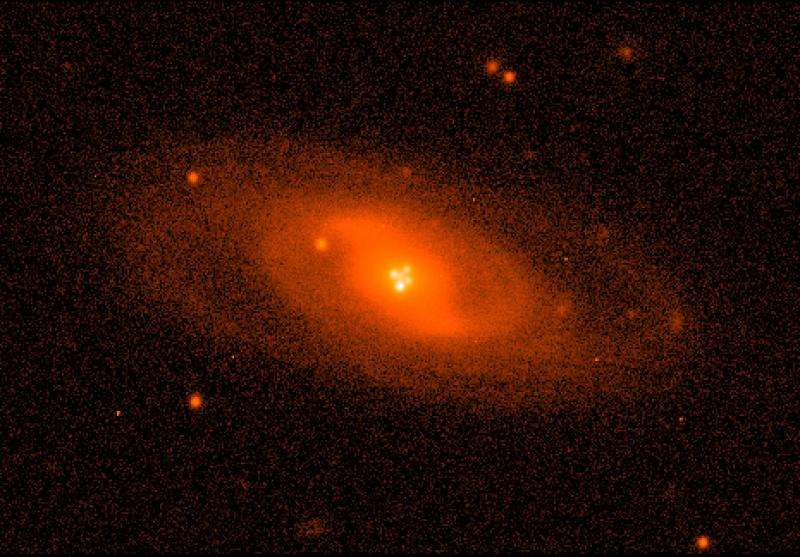A Spanish research team has obtained measurements for the innermost region of a disc of matter in orbital motion around a supermassive black hole in the quasar known as Einstein's Cross (Q2237-0305). It constitutes the most precise set of measurements achieved to date for such a small and distant object.
Typically, astronomers can only detect bright objects that emit a lot of light, or large objects blocking background light. Microlensing is used to study objects that emit little or no light, or are too far away to be detected any other way. Light traveling from the distant object bends around other objects lying directly between it and the observer, redirected by their gravitational fields. This leads to distorted, brightened and magnified images of the distant object which, when studied over time, can be reconciled to give a more complete picture. The object in the foreground essentially acts as a kind of lens, magnifying our view of very distant objects, like quasars and regions within them.
At the edge of a black hole
Quasars are very small, very distant objects that emit vast amounts of light. Their energy comes from mass falling onto the accretion disc, a disc of matter swirling extremely fast around a massive central body; in the case of quasars, around a supermassive black hole. Q2237-0305's accretion disc is comparable to the size of our solar system, but it is so far away that it has only been possible to measure its structure via microlensing.
By studying the variation in brightness of the four different images of the disc (the four points of the 'cross') provided by OGLE and GLITP gravitational microlensing projects, which have had their lenses trained on Einstein's Cross for over a decade, researchers have been able to obtain precise measurements of a structure at its innermost region, right at the edge of the black hole event horizon.
Over recent years we have shown how microlensing allows us to analyse the structure of accretion discs in quasars, and now we have obtained precise measurements for a structure right at the innermost rim, potentially the last stable orbit before the black hole event horizon", explains José Antonio Muñoz, lecturer at the Department of Astronomy and Astrophysics at the Universitat de València, who took part in this research alongside colleagues at the universities of Granada, Cadiz and the Canary Islands Astrophysics Institute.
His colleague, Jorge Jiménez Vicente, at the University of Granada adds that, "the big breakthrough here is that we have been able to do this for such a small disc, so far away – it is like being able to detect a one euro coin located over 100,000 kilometres away".
Currently only one in every 500 quasars can be measured in this way, since the alignment of the 'lens' and study objects must be very precise and is difficult to predict. However, Jiménez Vicente points to a future, when large-scale monitoring programs (like the 8.4 metre Large Synoptic Survey Telescope planned for northern Chile by 2022) are up-and-running, where "the detection of high magnification microlensing events like this one will be possible for thousands of quasars". This will open up a unique window onto the innermost edges of supermassive black holes in quasars, allowing researchers to gain a deeper understanding of this phenomenon and unlock the secrets to the formation and evolution of galaxies.
More information: Resolving the Innermost Region of the Accretion Disk of the Lensed Quasar Q2237+0305 Through Gravitational Microlensing. iopscience.iop.org/article/10. … /2041-8205/814/2/L26
Provided by Asociacion RUVID























